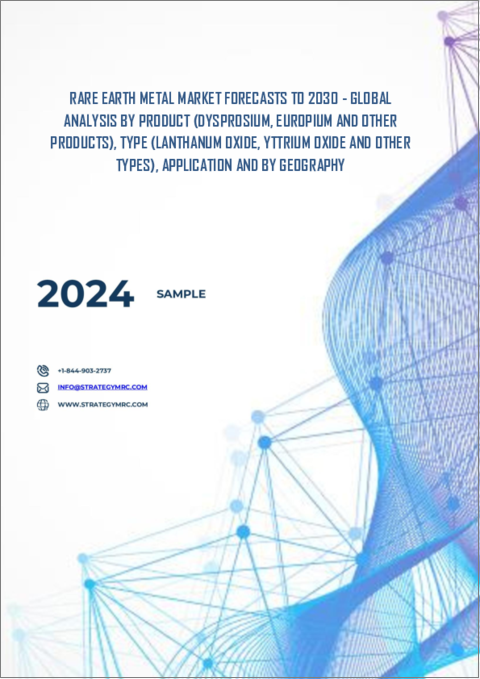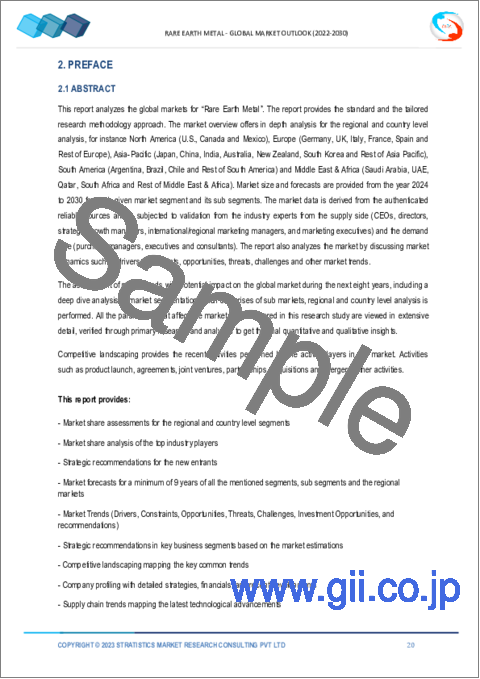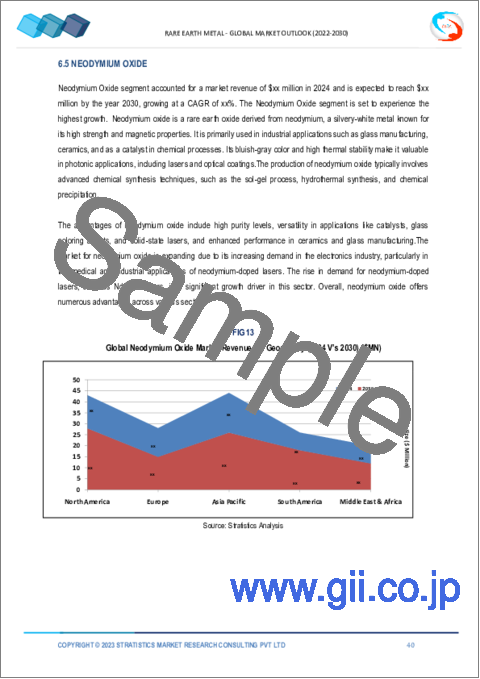|
|
市場調査レポート
商品コード
1511359
希土類金属の世界市場、2030年までの予測:製品別、タイプ別、用途別、地域別Rare Earth Metal Market Forecasts to 2030 - Global Analysis By Product (Dysprosium, Europium and Other Products), Type (Lanthanum Oxide, Yttrium Oxide and Other Types), Application and By Geography |
||||||
カスタマイズ可能
|
|||||||
| 希土類金属の世界市場、2030年までの予測:製品別、タイプ別、用途別、地域別 |
|
出版日: 2024年07月06日
発行: Stratistics Market Research Consulting
ページ情報: 英文 200+ Pages
納期: 2~3営業日
|
全表示
- 概要
- 図表
- 目次
Stratistics MRCによると、世界の希土類金属市場は2024年に68億6,000万米ドルを占め、2030年には153億9,000万米ドルに達すると予測され、予測期間中のCAGRは14.0%で成長する見込みです。
希土類金属は、スカンジウム、イットリウム、ランタノイドを含む周期表の17の化学元素のグループです。その名前とは裏腹に、地殻に比較的豊富に存在するが、化学的性質が似ているため、抽出・精製が難しいです。これらの金属は、磁石(ネオジム、サマリウム)、触媒(セリウム、ランタン)、エレクトロニクス(ユウロピウム、ガドリニウム)など、さまざまなハイテク用途に欠かせません。そのユニークな磁気特性、発光特性、触媒特性により、スマートフォンや風力タービンから医療用画像機器に至るまで、現代技術に欠かせないものとなっています。中国は現在、世界の生産量の大半を占めており、その戦略的重要性から地政学的な意味合いを持っています。
世界の技術需要
希土類金属(REM)はハイテク用途に不可欠なため、世界の技術需要が希土類金属(REM)市場の重要な促進要因となっています。ネオジム、ジスプロシウム、イットリウムなどのREMは、エレクトロニクス、再生可能エネルギー技術(風力タービンや電気自動車など)、高度医療機器の製造に不可欠です。技術が進歩するにつれてREMの必要性が高まり、市場力学に影響を及ぼしています。この需要は、電気自動車の台頭、5Gネットワークの拡大、再生可能エネルギー源の成長といった動向によって煽られており、これらすべてが性能と効率の面でREMに大きく依存しています。
世界の生産能力の限界
希土類金属市場における世界の生産能力の限界は、これらの重要な元素に対する需要の増大に対応するための、世界中の採掘および加工施設の能力に制約があることです。複雑な採掘プロセス、環境規制、地政学的配慮などの要因が、生産能力の拡大を制限しています。この制限は、希土類金属市場における供給不足と価格変動の一因となり、エレクトロニクス、再生可能エネルギーシステム、防衛用途などの先端技術において、これらの材料に依存している産業に影響を及ぼしています。
クリーンエネルギー技術
クリーンエネルギー技術は、風力タービン、電気自動車(EV)、ソーラーパネルなどの用途に不可欠な独自の磁気特性、発光特性、触媒特性により、希土類金属(REM)に大きく依存しています。このような技術の成長は、ネオジム、ジスプロシウム、テルビウムなどの元素の需要を促進し、希土類金属市場に大きな機会をもたらしました。炭素排出削減への世界の取り組みが強化されるにつれ、REMの需要はさらに高まると予想されます。しかし、市場はサプライチェーンの脆弱性や採掘・加工に関連する環境問題などの課題に直面しています。リサイクルと持続可能な抽出技術への投資は、拡大するクリーンエネルギー部門を活用しながらこうした課題を軽減する道を示すものです。
貿易政策と関税
世界的なサプライチェーンにより、貿易政策と関税は希土類金属(REM)市場に大きな影響を与える可能性があります。ハイテク産業にとって重要なREMに政府が関税を課すと、供給が途絶え、メーカーのコストが上昇する可能性があります。REMの生産は中国を中心とする数カ国に集中しているため、世界の供給が地政学的緊張や貿易紛争の影響を受けやすく、こうした脅威が生じる。関税の上昇は報復措置につながり、エレクトロニクス、再生可能エネルギー、防衛技術に不可欠なREMの市場アクセスと価格をさらに不安定化させる可能性があります。
COVID-19の影響:
COVID-19パンデミックは、世界のサプライチェーンの混乱と世界の産業活動の低下により、希土類金属市場に大きな影響を与えました。エレクトロニクスや再生可能エネルギーなどのハイテク産業に不可欠なこれらの金属は、供給不足と価格変動に直面しました。旅行規制は採掘作業と輸送を妨げ、生産と配送を制限しました。さらに、民生用電子機器や電気自動車に対する需要の変動が市場力学にさらに影響を与えました。景気が回復するにつれて、希土類金属市場は、産業活動の再開とグリーン技術への投資によって安定化すると予想されます。
イットリウムセグメントは予測期間中最大になると予想される
希土類金属であるイットリウムは、その多様な産業用途により顕著な成長を見せています。イットリウムは、LEDスクリーンやエネルギー効率の高い照明に使用される蛍光体に不可欠であり、世界の持続可能性の推進に貢献しています。イットリウムの需要は、超伝導体や様々な合金の生産においても高まっており、MRIスキャナーや航空宇宙部品のような先端技術における重要性を高めています。この成長は、ハイテクとグリーンエネルギー分野で不可欠なイットリウムのユニークな特性によってさらに促進され、現代の産業開発とイノベーションを形成する重要な役割を強調しています。
予測期間中、CAGRが最も高いのは冶金セグメント
希土類金属市場の冶金セグメントは、さまざまなハイテク用途で重要な役割を担っているため、大きな成長を遂げています。ネオジム、ジスプロシウム、テルビウムなどの希土類金属は、電気自動車(EV)、風力タービン、電子機器に使用される強力な磁石の生産に不可欠です。クリーンエネルギーソリューションと先端技術に対する世界の需要が高まり続けるにつれ、これらの特殊金属の必要性も高まっています。そのため、希土類金属の抽出と精製に合わせた冶金プロセスは、この需要を満たす上で極めて重要となっています。
最大のシェアを持つ地域:
近年、北米は、いくつかの要因によって希土類金属市場で著しい成長を見せています。重要な要因の1つは、歴史的に世界生産の大半を占めてきた中国供給への依存を減らすことに、この地域が戦略的に重点を置いていることです。新たな採掘プロジェクトへの投資と、採掘と加工における技術革新により、国内の生産能力が強化されています。さらに、エレクトロニクス、再生可能エネルギー、防衛などのハイテク産業で希土類金属が果たす重要な役割に対する認識が高まり、需要に拍車がかかっています。
CAGRが最も高い地域:
アジア太平洋地域は、いくつかの要因により希土類金属市場で著しい成長を遂げています。中国のような国々が生産量を独占しており、世界生産量の主要シェアを占めています。電子機器、再生可能エネルギー技術、防衛用途の技術進歩に牽引され、需要が急増しています。さらに、地政学的な変化により希土類金属の戦略的重要性が強調され、この地域の国々は生産と加工能力を強化するようになった。このような成長軌道は、従来の抽出方法に関連するサプライチェーンのリスクや環境上の懸念を軽減するためのリサイクルや代替ソースの継続的な調査によってさらに支えられています。
無料カスタマイズサービス:
本レポートをご購読のお客様には、以下の無料カスタマイズオプションのいずれかをご利用いただけます:
- 企業プロファイル
- 追加市場プレーヤーの包括的プロファイリング(3社まで)
- 主要企業のSWOT分析(3社まで)
- 地域セグメンテーション
- 顧客の関心に応じた主要国の市場推計・予測・CAGR(注:フィージビリティチェックによる)
- 競合ベンチマーキング
- 製品ポートフォリオ、地理的プレゼンス、戦略的提携に基づく主要企業のベンチマーキング
目次
第1章 エグゼクティブサマリー
第2章 序文
- 概要
- ステークホルダー
- 調査範囲
- 調査手法
- データマイニング
- データ分析
- データ検証
- 調査アプローチ
- 調査情報源
- 1次調査情報源
- 2次調査情報源
- 前提条件
第3章 市場動向分析
- 促進要因
- 抑制要因
- 機会
- 脅威
- 製品分析
- 用途分析
- 新興市場
- COVID-19の影響
第4章 ポーターのファイブフォース分析
- 供給企業の交渉力
- 買い手の交渉力
- 代替品の脅威
- 新規参入業者の脅威
- 競争企業間の敵対関係
第5章 世界の希土類金属市場:製品別
- ジスプロシウム
- ユーロピウム
- ホルミウム
- ルテチウム
- プラセオジム
- サマリウム
- テルビウム
- イッテルビウム
- セリウム
- エルビウム
- ガドリニウム
- ランタン
- ネオジム
- プロメチウム
- スカンジウム
- ツリウム
- イットリウム
- その他
第6章 世界の希土類金属市場:タイプ別
- 酸化ランタン
- 酸化イットリウム
- 酸化セリウム
- 酸化ネオジム
- その他
第7章 世界の希土類金属市場:用途別
- 触媒
- 研磨
- 蛍光体
- セラミックス
- ガラス
- 冶金
- 磁石
- その他
第8章 世界の希土類金属市場:地域別
- 北米
- 米国
- カナダ
- メキシコ
- 欧州
- ドイツ
- 英国
- イタリア
- フランス
- スペイン
- その他欧州
- アジア太平洋地域
- 日本
- 中国
- インド
- オーストラリア
- ニュージーランド
- 韓国
- その他アジア太平洋地域
- 南米
- アルゼンチン
- ブラジル
- チリ
- その他南米
- 中東・アフリカ
- サウジアラビア
- アラブ首長国連邦
- カタール
- 南アフリカ
- その他中東・アフリカ
第9章 主な発展
- 契約、パートナーシップ、コラボレーション、合弁事業
- 買収と合併
- 新製品発売
- 事業拡大
- その他の主要戦略
第10章 企業プロファイリング
- Alkane Resources Ltd.
- Aluminum Corporation of China Ltd
- Arafura Resources Ltd.
- Avalon Advanced Materials Inc.
- Canada Rare Earth Corporation
- China Minmetals
- China Nonferrous Metal Industry's Foreign Engineering and Construction Co. Ltd
- Great Western Minerals Group Ltd.
- Iluka Resources Limited
- Indian Rare Earth
- Lynas Corporation Ltd.
- Minmetals Land Limited
- Molycorp Inc.
- NORTHERN MINERALS
- Peak Resources
- Rare Element Resources Ltd
- Rio Tinto
- Shin-Etsu Chemical Co. Ltd
- Ucore Rare Metals Inc.
- Xiamen Tungsten Co. Ltd
List of Tables
- Table 1 Global Rare Earth Metal Market Outlook, By Region (2022-2030) ($MN)
- Table 2 Global Rare Earth Metal Market Outlook, By Product (2022-2030) ($MN)
- Table 3 Global Rare Earth Metal Market Outlook, By Dysprosium (2022-2030) ($MN)
- Table 4 Global Rare Earth Metal Market Outlook, By Europium (2022-2030) ($MN)
- Table 5 Global Rare Earth Metal Market Outlook, By Holmium (2022-2030) ($MN)
- Table 6 Global Rare Earth Metal Market Outlook, By Lutetium (2022-2030) ($MN)
- Table 7 Global Rare Earth Metal Market Outlook, By Praseodymium (2022-2030) ($MN)
- Table 8 Global Rare Earth Metal Market Outlook, By Samarium (2022-2030) ($MN)
- Table 9 Global Rare Earth Metal Market Outlook, By Terbium (2022-2030) ($MN)
- Table 10 Global Rare Earth Metal Market Outlook, By Ytterbium (2022-2030) ($MN)
- Table 11 Global Rare Earth Metal Market Outlook, By Cerium (2022-2030) ($MN)
- Table 12 Global Rare Earth Metal Market Outlook, By Erbium (2022-2030) ($MN)
- Table 13 Global Rare Earth Metal Market Outlook, By Gadolinium (2022-2030) ($MN)
- Table 14 Global Rare Earth Metal Market Outlook, By Lanthanum (2022-2030) ($MN)
- Table 15 Global Rare Earth Metal Market Outlook, By Neodymium (2022-2030) ($MN)
- Table 16 Global Rare Earth Metal Market Outlook, By Promethium (2022-2030) ($MN)
- Table 17 Global Rare Earth Metal Market Outlook, By Scandium (2022-2030) ($MN)
- Table 18 Global Rare Earth Metal Market Outlook, By Thulium (2022-2030) ($MN)
- Table 19 Global Rare Earth Metal Market Outlook, By Yttrium (2022-2030) ($MN)
- Table 20 Global Rare Earth Metal Market Outlook, By Other Products (2022-2030) ($MN)
- Table 21 Global Rare Earth Metal Market Outlook, By Type (2022-2030) ($MN)
- Table 22 Global Rare Earth Metal Market Outlook, By Lanthanum Oxide (2022-2030) ($MN)
- Table 23 Global Rare Earth Metal Market Outlook, By Yttrium Oxide (2022-2030) ($MN)
- Table 24 Global Rare Earth Metal Market Outlook, By Cerium Oxide (2022-2030) ($MN)
- Table 25 Global Rare Earth Metal Market Outlook, By Neodymium Oxide (2022-2030) ($MN)
- Table 26 Global Rare Earth Metal Market Outlook, By Other Types (2022-2030) ($MN)
- Table 27 Global Rare Earth Metal Market Outlook, By Application (2022-2030) ($MN)
- Table 28 Global Rare Earth Metal Market Outlook, By Catalysts (2022-2030) ($MN)
- Table 29 Global Rare Earth Metal Market Outlook, By Polishing (2022-2030) ($MN)
- Table 30 Global Rare Earth Metal Market Outlook, By Phosphors (2022-2030) ($MN)
- Table 31 Global Rare Earth Metal Market Outlook, By Ceramics (2022-2030) ($MN)
- Table 32 Global Rare Earth Metal Market Outlook, By Glass (2022-2030) ($MN)
- Table 33 Global Rare Earth Metal Market Outlook, By Metallurgy (2022-2030) ($MN)
- Table 34 Global Rare Earth Metal Market Outlook, By Magnets (2022-2030) ($MN)
- Table 35 Global Rare Earth Metal Market Outlook, By Other Applications (2022-2030) ($MN)
Note: Tables for North America, Europe, APAC, South America, and Middle East & Africa Regions are also represented in the same manner as above.
According to Stratistics MRC, the Global Rare Earth Metal Market is accounted for $6.86 billion in 2024 and is expected to reach $15.39 billion by 2030 growing at a CAGR of 14.0% during the forecast period. Rare earth metals are a group of 17 chemical elements in the periodic table, including scandium, yttrium, and the lanthanides. Despite their name, they are relatively abundant in the Earth's crust but are challenging to extract and refine due to their similar chemical properties. These metals are crucial in various high-tech applications such as magnets (neodymium, samarium), catalysts (cerium, lanthanum), and electronics (europium, gadolinium). Their unique magnetic, luminescent, and catalytic properties make them indispensable in modern technologies, from smartphones and wind turbines to medical imaging devices. China currently dominates global production, posing geopolitical implications due to its strategic importance.
According to the World Nuclear Association, two nuclear reactors are under construction in the U.S country.
Market Dynamics:
Driver:
Global demand for technology
The global demand for technology is a significant driver of the rare earth metal (REM) market due to their indispensable use in high-tech applications. REMs such as neodymium, dysprosium, and yttrium are crucial for manufacturing electronics, renewable energy technologies (like wind turbines and electric vehicles), and advanced medical equipment. As technology advances, the need for REMs increases, influencing their market dynamics. This demand is fueled by trends like the rise of electric vehicles, the expansion of 5G networks, and growth in renewable energy sources, all of which heavily rely on REMs for their performance and efficiency.
Restraint:
Limited global production capacity
Limited global production capacity in the rare earth metals market is the constrained ability of mining and processing facilities worldwide to meet the growing demand for these critical elements. Factors such as complex extraction processes, environmental regulations, and geopolitical considerations restrict the expansion of production capabilities. This limitation contributes to supply shortages and price volatility in the rare earth metals market, impacting industries reliant on these materials for advanced technologies like electronics, renewable energy systems, and defense applications.
Opportunity:
Clean energy technologies
Clean energy technologies heavily rely on rare earth metals (REMs) due to their unique magnetic, luminescent, and catalytic properties essential for applications like wind turbines, electric vehicles (EVs), and solar panels. The growth of these technologies has created a significant opportunity in the rare earth metal market, driving demand for elements such as neodymium, dysprosium, and terbium. As global efforts intensify to reduce carbon emissions, the demand for REMs is expected to rise further. However, the market faces challenges, including supply chain vulnerabilities and environmental concerns related to mining and processing. Investment in recycling and sustainable extraction technologies presents avenues for mitigating these challenges while capitalizing on the expanding clean energy sector.
Threat:
Trade policies and tariffs
Trade policies and tariffs can significantly impact the rare earth metal (REM) market due to its global supply chain. Governments imposing tariffs on REMs, which are critical for high-tech industries, can disrupt supply and increase costs for manufacturers. This threat arises because REM production is concentrated in a few countries, primarily China, making global supply vulnerable to geopolitical tensions and trade disputes. Higher tariffs can lead to retaliatory measures, further destabilizing market access and prices for REMs essential in electronics, renewable energy, and defense technologies.
Covid-19 Impact:
The COVID-19 pandemic significantly impacted the rare earth metals market due to disruptions in global supply chains and reduced industrial activity worldwide. These metals, crucial for high-tech industries like electronics and renewable energy, faced supply shortages and price fluctuations. Travel restrictions hindered mining operations and transportation, limiting production and delivery. Moreover, fluctuating demand for consumer electronics and electric vehicles further influenced market dynamics. As economies recover, the rare earth metals market is expected to stabilize, driven by renewed industrial activity and investments in green technologies.
The yttrium segment is expected to be the largest during the forecast period
Yttrium, a rare earth metal, has seen notable growth due to its diverse industrial applications. It is essential in phosphors used for LED screens and energy-efficient lighting, contributing to the global push for sustainability. Yttrium's demand has also risen in the production of superconductors and various alloys, enhancing its significance in advanced technologies like MRI scanners and aerospace components. This growth is further fueled by its unique properties that make it indispensable in high-tech and green energy sectors, highlighting its crucial role in shaping modern industrial developments and innovations.
The metallurgy segment is expected to have the highest CAGR during the forecast period
The metallurgy segment in the rare earth metal market has seen significant growth due to its crucial role in various high-tech applications. Rare earth metals like neodymium, dysprosium, and terbium are indispensable in the production of powerful magnets used in electric vehicles (EVs), wind turbines, and electronics. As global demand for clean energy solutions and advanced technologies continues to rise, so does the need for these specialized metals. Metallurgical processes tailored for extracting and refining rare earth metals have thus become pivotal in meeting this demand.
Region with largest share:
In recent years, North America has shown significant growth in the rare earth metal market, driven by several factors. One key factor is the region's strategic focus on reducing dependency on Chinese supply, which has historically dominated global production. Investments in new mining projects and technological innovations in extraction and processing have bolstered domestic production capacity. Additionally, heightened awareness of the critical role rare earth metals play in high-tech industries like electronics, renewable energy, and defense has spurred demand.
Region with highest CAGR:
The Asia-Pacific region has experienced significant growth in the rare earth metals market due to several factors. Countries like China dominate production, accounting for a major share of global output. Demand has surged, driven by technological advancements in electronics, renewable energy technologies and defense applications. Moreover, geopolitical shifts have underscored the strategic importance of rare earths, prompting nations in the region to bolster production and processing capabilities. This growth trajectory is further supported by ongoing research into recycling and alternative sources to mitigate supply chain risks and environmental concerns associated with traditional extraction methods.
Key players in the market
Some of the key players in Rare Earth Metal market include Alkane Resources Ltd., Aluminum Corporation of China Ltd, Arafura Resources Ltd., Avalon Advanced Materials Inc., Canada Rare Earth Corporation, China Minmetals, China Nonferrous Metal Industry's Foreign Engineering and Construction Co. Ltd, Great Western Minerals Group Ltd., Iluka Resources Limited, Indian Rare Earth, Lynas Corporation Ltd., Minmetals Land Limited, Molycorp Inc., NORTHERN MINERALS, Peak Resources, Rare Element Resources Ltd, Rio Tinto, Shin-Etsu Chemical Co. Ltd, Ucore Rare Metals Inc. and Xiamen Tungsten Co. Ltd.
Key Developments:
In June 2024, Serbia is poised to grant Rio Tinto RIO approval to develop Europe's largest lithium mine. The Jadar project, which was suspended in 2022, could start production by 2028, providing Europe with metal much needed for its electric vehicle (EV) industry.
In November 2023, Rare Element Resources has announced the completion of the US Department of Energy (DoE) Office of Energy Efficiency and Renewable Energy's National Environmental Policy Act (NEPA) review, for the construction of a rare earth processing and separation demonstration plant in Wyoming.
Products Covered:
- Dysprosium
- Europium
- Holmium
- Lutetium
- Praseodymium
- Samarium
- Terbium
- Ytterbium
- Cerium
- Erbium
- Gadolinium
- Lanthanum
- Neodymium
- Promethium
- Scandium
- Thulium
- Yttrium
- Other Products
Types Covered:
- Lanthanum Oxide
- Yttrium Oxide
- Cerium Oxide
- Neodymium Oxide
- Other Types
Applications Covered:
- Catalysts
- Polishing
- Phosphors
- Ceramics
- Glass
- Metallurgy
- Magnets
- Other Applications
Regions Covered:
- North America
- US
- Canada
- Mexico
- Europe
- Germany
- UK
- Italy
- France
- Spain
- Rest of Europe
- Asia Pacific
- Japan
- China
- India
- Australia
- New Zealand
- South Korea
- Rest of Asia Pacific
- South America
- Argentina
- Brazil
- Chile
- Rest of South America
- Middle East & Africa
- Saudi Arabia
- UAE
- Qatar
- South Africa
- Rest of Middle East & Africa
What our report offers:
- Market share assessments for the regional and country-level segments
- Strategic recommendations for the new entrants
- Covers Market data for the years 2022, 2023, 2024, 2026, and 2030
- Market Trends (Drivers, Constraints, Opportunities, Threats, Challenges, Investment Opportunities, and recommendations)
- Strategic recommendations in key business segments based on the market estimations
- Competitive landscaping mapping the key common trends
- Company profiling with detailed strategies, financials, and recent developments
- Supply chain trends mapping the latest technological advancements
Free Customization Offerings:
All the customers of this report will be entitled to receive one of the following free customization options:
- Company Profiling
- Comprehensive profiling of additional market players (up to 3)
- SWOT Analysis of key players (up to 3)
- Regional Segmentation
- Market estimations, Forecasts and CAGR of any prominent country as per the client's interest (Note: Depends on feasibility check)
- Competitive Benchmarking
- Benchmarking of key players based on product portfolio, geographical presence, and strategic alliances
Table of Contents
1 Executive Summary
2 Preface
- 2.1 Abstract
- 2.2 Stake Holders
- 2.3 Research Scope
- 2.4 Research Methodology
- 2.4.1 Data Mining
- 2.4.2 Data Analysis
- 2.4.3 Data Validation
- 2.4.4 Research Approach
- 2.5 Research Sources
- 2.5.1 Primary Research Sources
- 2.5.2 Secondary Research Sources
- 2.5.3 Assumptions
3 Market Trend Analysis
- 3.1 Introduction
- 3.2 Drivers
- 3.3 Restraints
- 3.4 Opportunities
- 3.5 Threats
- 3.6 Product Analysis
- 3.7 Application Analysis
- 3.8 Emerging Markets
- 3.9 Impact of Covid-19
4 Porters Five Force Analysis
- 4.1 Bargaining power of suppliers
- 4.2 Bargaining power of buyers
- 4.3 Threat of substitutes
- 4.4 Threat of new entrants
- 4.5 Competitive rivalry
5 Global Rare Earth Metal Market, By Product
- 5.1 Introduction
- 5.2 Dysprosium
- 5.3 Europium
- 5.4 Holmium
- 5.5 Lutetium
- 5.6 Praseodymium
- 5.7 Samarium
- 5.8 Terbium
- 5.9 Ytterbium
- 5.10 Cerium
- 5.11 Erbium
- 5.12 Gadolinium
- 5.13 Lanthanum
- 5.14 Neodymium
- 5.15 Promethium
- 5.16 Scandium
- 5.17 Thulium
- 5.18 Yttrium
- 5.19 Other Products
6 Global Rare Earth Metal Market, By Type
- 6.1 Introduction
- 6.2 Lanthanum Oxide
- 6.3 Yttrium Oxide
- 6.4 Cerium Oxide
- 6.5 Neodymium Oxide
- 6.6 Other Types
7 Global Rare Earth Metal Market, By Application
- 7.1 Introduction
- 7.2 Catalysts
- 7.3 Polishing
- 7.4 Phosphors
- 7.5 Ceramics
- 7.6 Glass
- 7.7 Metallurgy
- 7.8 Magnets
- 7.9 Other Applications
8 Global Rare Earth Metal Market, By Geography
- 8.1 Introduction
- 8.2 North America
- 8.2.1 US
- 8.2.2 Canada
- 8.2.3 Mexico
- 8.3 Europe
- 8.3.1 Germany
- 8.3.2 UK
- 8.3.3 Italy
- 8.3.4 France
- 8.3.5 Spain
- 8.3.6 Rest of Europe
- 8.4 Asia Pacific
- 8.4.1 Japan
- 8.4.2 China
- 8.4.3 India
- 8.4.4 Australia
- 8.4.5 New Zealand
- 8.4.6 South Korea
- 8.4.7 Rest of Asia Pacific
- 8.5 South America
- 8.5.1 Argentina
- 8.5.2 Brazil
- 8.5.3 Chile
- 8.5.4 Rest of South America
- 8.6 Middle East & Africa
- 8.6.1 Saudi Arabia
- 8.6.2 UAE
- 8.6.3 Qatar
- 8.6.4 South Africa
- 8.6.5 Rest of Middle East & Africa
9 Key Developments
- 9.1 Agreements, Partnerships, Collaborations and Joint Ventures
- 9.2 Acquisitions & Mergers
- 9.3 New Product Launch
- 9.4 Expansions
- 9.5 Other Key Strategies
10 Company Profiling
- 10.1 Alkane Resources Ltd.
- 10.2 Aluminum Corporation of China Ltd
- 10.3 Arafura Resources Ltd.
- 10.4 Avalon Advanced Materials Inc.
- 10.5 Canada Rare Earth Corporation
- 10.6 China Minmetals
- 10.7 China Nonferrous Metal Industry's Foreign Engineering and Construction Co. Ltd
- 10.8 Great Western Minerals Group Ltd.
- 10.9 Iluka Resources Limited
- 10.10 Indian Rare Earth
- 10.11 Lynas Corporation Ltd.
- 10.12 Minmetals Land Limited
- 10.13 Molycorp Inc.
- 10.14 NORTHERN MINERALS
- 10.15 Peak Resources
- 10.16 Rare Element Resources Ltd
- 10.17 Rio Tinto
- 10.18 Shin-Etsu Chemical Co. Ltd
- 10.19 Ucore Rare Metals Inc.
- 10.20 Xiamen Tungsten Co. Ltd





